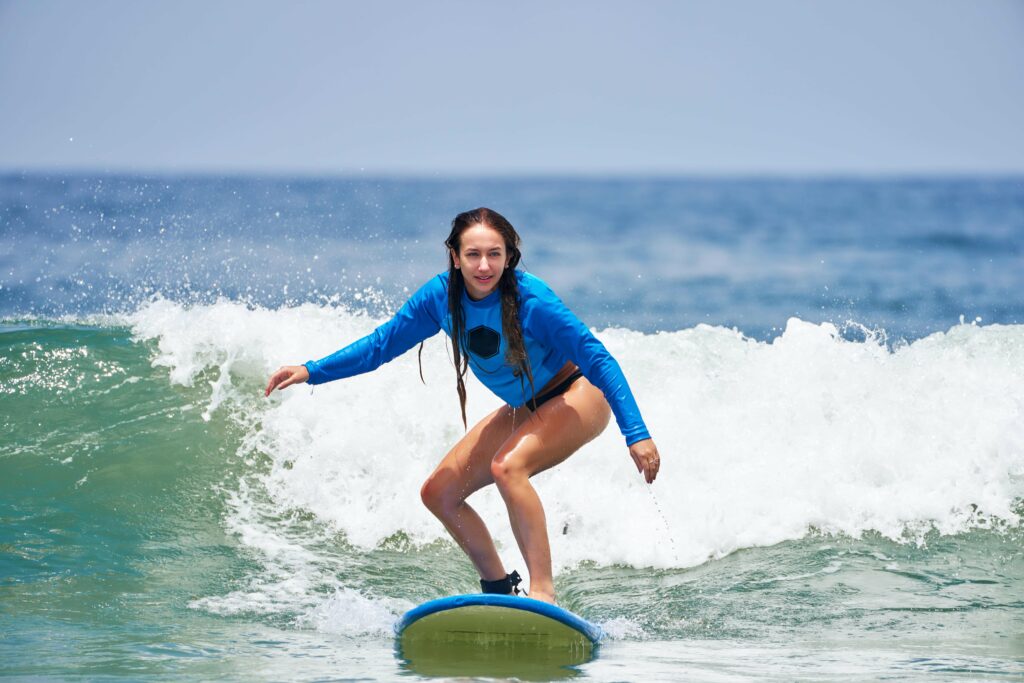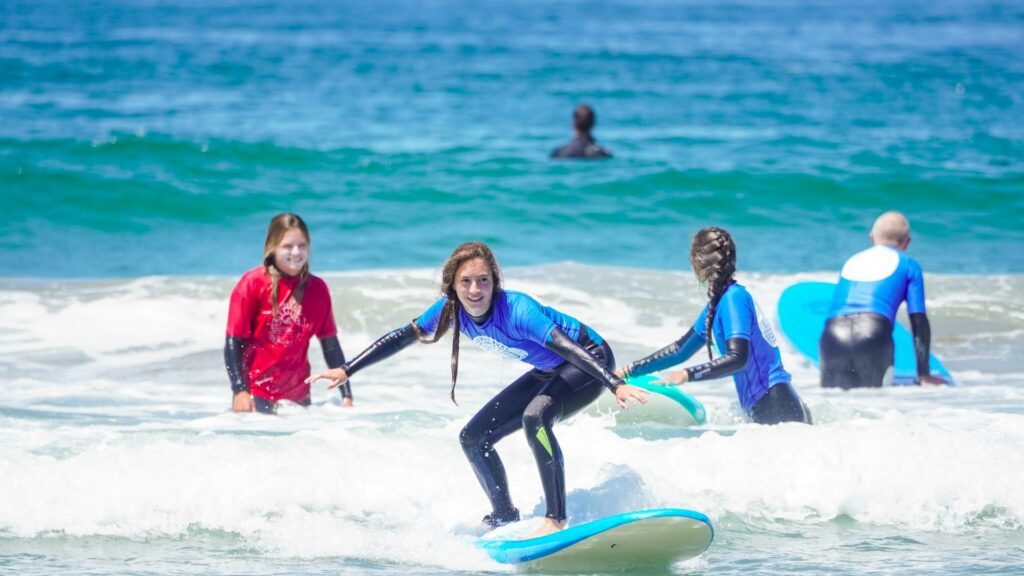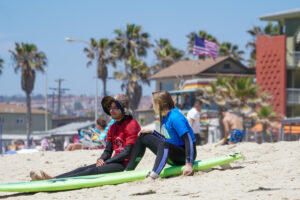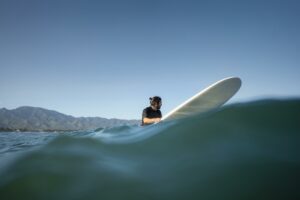10 Essential Safety Tips for Surfing
When it comes to embracing the exhilarating world of surfing, the ocean’s allure is undeniable. However, amid the thrill of riding the waves, one aspect remains paramount: surfing safety. In this comprehensive guide, we dive into the essential safety tips for surfing that every enthusiast, from beginners to seasoned wave riders, should know. As we explore the art of staying safe while catching the perfect wave, you’ll gain valuable insights and expert advice to ensure your surfing experience is not only exciting but secure. Join us on this journey as we equip you with the knowledge and skills needed to navigate the ocean with confidence and peace of mind.

1. Choose the Right Surf Spot
Selecting the right surf spot is crucial for your safety. Research the location’s wave conditions, water depth, and potential hazards. Look for spots suitable for your skill level. Choosing a crowded beach with experienced surfers may not be ideal for beginners.
2. Use the Right Surfboard
Ensure your surfboard matches your skill level and the conditions. Longer boards are stable and perfect for beginners, while shorter boards are more maneuverable but require experience to handle. Using the right board prevents accidents and maximizes your enjoyment.
3. Wear the Right Surfing Gear
Invest in proper surfing gear, including a well-fitting wetsuit, leash, and rash guard. These items provide protection from cold water, sunburn, and board-related injuries. A leash keeps your board nearby, preventing it from becoming a hazard to others.
4. Learn to Read the Waves
Understanding wave patterns is essential. Before paddling out, observe the waves for a while. Recognize rip currents, shore breaks, and sets. Knowing how to navigate through waves helps prevent accidents and exhaustion.
5. Warm-Up and Stretch
Surfing demands physical effort. Perform warm-up exercises and stretches before hitting the water to prevent muscle strains and injuries. A limber body ensures better control and balance on the board.
6. Practice Safe Entry and Exit
Entering and exiting the water can be tricky. Always keep your board in front of you and watch for other surfers. Never turn your back on the waves, as they can catch you off guard.
7. Respect Other Surfers
Surfing etiquette is essential for safety and harmony. Yield the right of way to surfers already riding a wave. Avoid “drop-ins” and collisions by communicating with fellow surfers. Respect the lineup and take turns.
8. Be Aware of Marine Life
Ocean environments are teeming with marine life. While encounters with sharks are rare, it’s essential to stay informed about local wildlife. Stingrays and jellyfish can pose a threat, so shuffle your feet when walking in shallow water to avoid stepping on them.
9. Stay Hydrated and Sun-Protected
Surfing can be physically demanding, so remember to stay hydrated. Apply waterproof sunscreen to protect your skin from the sun’s harmful rays. Dehydration and sunburn can quickly spoil your day.
10. Know Your Limits
Finally, always know your limits. Don’t push yourself too hard or attempt waves beyond your skill level. Recognize when it’s time to call it a day and rest. Ignoring fatigue and danger signs can lead to accidents.
Surf Spots to Choose From in San Diego
Here’s an overview of beginner-friendly surf spots in San Diego:
Pacific Beach
Pacific Beach, often referred to as “PB” by locals, is one of San Diego’s most popular surf destinations, perfect for beginners. The consistent, mellow waves make it an ideal spot for those just starting their surfing journey. With a sandy bottom and generally smaller waves, PB provides a forgiving environment for learning the ropes.
Sign up for surfing lessons at Pacific Beach.
La Jolla Shores
La Jolla Shores is another excellent choice for beginners. The gentle, rolling waves and sandy bottom create a welcoming atmosphere for surfers of all levels. This location also benefits from the stunning backdrop of the La Jolla cliffs, adding to the overall surf experience. Local surf schools often frequent this spot, offering lessons for newcomers to the sport.
Sign up for surfing lessons at La Jolla.
Mission Beach
Mission Beach offers a laid-back surfing experience that’s perfect for beginners. The wide sandy shoreline provides ample space for learning without crowded lineups. The consistent, manageable waves make it an excellent spot for honing your skills. After your surf session, you can enjoy the vibrant boardwalk and nearby attractions.
Sign up for surfing lessons at Mission Beach.
Ocean Beach
Ocean Beach (OB) is known for its friendly and welcoming surf community. While it offers waves suitable for more advanced surfers on some days, there are also days when OB’s waves are beginner-friendly. The mellow atmosphere and local surf shops make it an ideal spot to learn and connect with fellow surf enthusiasts. OB’s unique charm extends beyond surfing, with eclectic shops and restaurants to explore.
Sign up for surfing lessons at Ocean Beach.
Learn Safety Tips for Surfing at Pacific Surf School
At Pacific Surf School, we’re more than just a surf school; we’re your gateway to a thrilling and safe surfing experience in the heart of San Diego. Whether you’re new to surfing or looking to take your skills to the next level, our dedicated team of expert instructors is here to guide you every step of the way.
Our range of lessons, including private, semi-private, and group surf lessons, ensures that we cater to surfers of all levels and preferences. With Pacific Surf School, safety is our priority. You won’t just learn how to ride the waves; you’ll master the essential safety tips that will allow you to surf with confidence and peace of mind.
Join our surf community today, and let us introduce you to the world of surfing in a fun and secure environment. If you’re in San Diego, don’t miss the opportunity to catch the perfect wave with Pacific Surf School. Contact us now, and let’s embark on an exciting surfing adventure together!

FAQs
While surfing, avoid turning your back on incoming waves, as they can catch you off guard. Also, refrain from dropping in on other surfers’ waves, and always yield the right of way to those already riding a wave. Lastly, don’t ignore local surf etiquette and regulations.
Surfing can be physically demanding and carries inherent risks associated with ocean conditions. However, with proper training, awareness, and adherence to safety guidelines, it can be a relatively safe sport. Like any activity, understanding and mitigating risks are key to enjoying surfing safely.
Risk factors in surfing include wave size and intensity, rip currents, collisions with other surfers or objects, and encounters with marine life. Inexperienced surfers, inadequate knowledge of local conditions, and ignoring safety precautions can also increase the risk.
The safety of a surf spot depends on factors like your skill level, wave conditions, and local knowledge. Generally, beginner-friendly spots with smaller, rolling waves and sandy bottoms, such as Pacific Beach and La Jolla Shores in San Diego, are safer options for those new to surfing. However, always research and assess conditions before heading out to any surf location.




